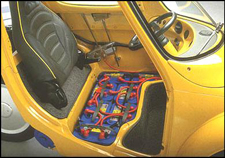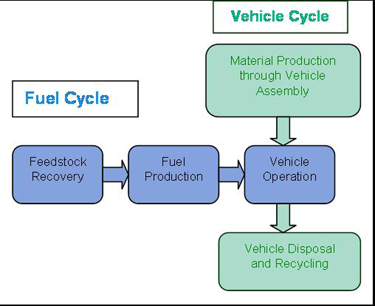CEEESA Energy Systems Analysis Tools
The Center for Energy, Environmental, and Economic Systems Analysis (CEEESA) provides energy systems analysis tools that cover a wide range of issues. The table below summarizes the available models. Click on each model name to get more information.
Model for Analysis of Energy Demand (MAED)
 Described as a strategic, scenario-based, simulation model, MAED performs long-term energy and electricity demand forecasting. Future energy demand is estimated by using a bottom-up approach in which useful energy demands for specific activities are projected. Energy consumption levels for individual activities are then aggregated to project total future demand for fossil fuels, electricity, district heating, coke, and feedstocks in each sector/subsector of the economy. Described as a strategic, scenario-based, simulation model, MAED performs long-term energy and electricity demand forecasting. Future energy demand is estimated by using a bottom-up approach in which useful energy demands for specific activities are projected. Energy consumption levels for individual activities are then aggregated to project total future demand for fossil fuels, electricity, district heating, coke, and feedstocks in each sector/subsector of the economy.
Designed to reflect the structural changes in energy demand, MAED performs detailed analyses of social, economic, and technological developments, as well as policy issues. The latest version is spreadsheet-based and offers much more flexibility in defining a country’s energy system representation. MAED is distributed by the International Atomic Energy Agency. Argonne provides technical support.
For more information about Model for Analysis of Energy Demand (MAED), contact CEEESA.
Energy and Power Evaluation Program (ENPEP-BALANCE)
 The Windows version of the Energy and Power Evaluation Program (ENPEP-BALANCE) is the premier energy systems analysis software in use in over 80 countries. ENPEP-BALANCE
was developed by CEEESA with support from the U.S. Department of
Energy. ENPEP-BALANCE allows users to evaluate the entire energy system (supply and demand side) and the environmental implications of different energy strategies. The
latest ENPEP-BALANCE version takes full advantage of the Windows operating environment. The Windows version of the Energy and Power Evaluation Program (ENPEP-BALANCE) is the premier energy systems analysis software in use in over 80 countries. ENPEP-BALANCE
was developed by CEEESA with support from the U.S. Department of
Energy. ENPEP-BALANCE allows users to evaluate the entire energy system (supply and demand side) and the environmental implications of different energy strategies. The
latest ENPEP-BALANCE version takes full advantage of the Windows operating environment.
The nonlinear equilibrium ENPEP-BALANCE model matches the demand for energy with available resources and technologies. Its market-based simulation approach allows ENPEP-BALANCE to determine the responses of various segments of the energy system to changes in energy prices and demand levels. The model relies on a decentralized decision-making process in the energy sector, and it can be calibrated to the different preferences of energy users and suppliers. ENPEP-BALANCE uses a network that consists of different nodes and links, which represent various energy systems. Nodes in the network represent depletable and renewable resources, various conversion processes, refineries, thermal and hydro power stations, cogeneration units, boilers and furnaces, marketplace competition, taxes and subsidies, and energy demands. Links connect the nodes and transfer information among nodes.
ENPEP-BALANCE is very versatile in that the analyst starts with an empty workspace and builds an energy system configuration of nodes and links. ENPEP-BALANCE's powerful graphical user interface makes it as easy as “drag and drop” to build networks of regional, national, or multinational scope. Drop-down menus can be used to display model inputs and results directly within the energy network. Double-clicking the nodes allows access to more detailed information. The latest ENPEP-BALANCE version also incorporates calculations of environmental residuals, such as atmospheric pollution, water effluents, and waste generation. ENPEP-BALANCE is used extensively in the global community to conduct greenhouse gas mitigation analyses, energy policy studies, and natural gas market analyses.
Click here for more details on the ENPEP-BALANCE model.
For more information about Energy and Power Evaluation Program (ENPEP-BALANCE), contact CEEESA.
Integrated Market Penetration and Anticipated Cost of Transportation Technologies (IMPACTT)
 IMPACTT is a stock adjustment model used to assess on-road changes in fleet fuel consumption and emissions as the new light-duty vehicle mix of technologies changes over time. In general, IMPACTT simulates survival and usage of vehicle stock. The model maintains vintage and technology-specific information and thus can estimate vehicle stock and use, energy use, and emissions by disaggregate categories such as fuel type, vehicle type, and technology. IMPACTT is a stock adjustment model used to assess on-road changes in fleet fuel consumption and emissions as the new light-duty vehicle mix of technologies changes over time. In general, IMPACTT simulates survival and usage of vehicle stock. The model maintains vintage and technology-specific information and thus can estimate vehicle stock and use, energy use, and emissions by disaggregate categories such as fuel type, vehicle type, and technology.
IMPACTT can produce secondary outputs by fuel, vehicle type, size class, and technology. It has also been used to assess the impacts of engine technologies, alternative fuels, and lightweight materials. In one of its specialized versions, the model simulated the use of new and recycled aluminum and the resulting changes in energy use over a vehicle’s life cycle.
IMPACTT was developed and is distributed by Argonne’s Center for Transportation Research.
For more information about Integrated Market Penetration and Anticipated Cost of Transportation Technologies (IMPACTT), contact CEEESA.
Electric Vehicle Life-cycle Cost Model (EV-LCM)
 The EV-LCM estimates the life-cycle costs of electric vehicles (EVs) for their buyers in the United States. The model is based on an analysis of conventional vehicle costs, costs of drive train and auxiliary components unique to EVs, and battery costs. Conventional vehicle production and marketing costs are allocated to subsystems such as body, chassis, and power train. Because an electric drive replaces the conventional power train in EVs, a procedure for amortizing purchase price, replacement battery costs, and operating costs over a vehicle’s lifetime is part of the methodology. The EV-LCM estimates the life-cycle costs of electric vehicles (EVs) for their buyers in the United States. The model is based on an analysis of conventional vehicle costs, costs of drive train and auxiliary components unique to EVs, and battery costs. Conventional vehicle production and marketing costs are allocated to subsystems such as body, chassis, and power train. Because an electric drive replaces the conventional power train in EVs, a procedure for amortizing purchase price, replacement battery costs, and operating costs over a vehicle’s lifetime is part of the methodology.
The procedure computes power requirements, purchase price, initial and replacement battery costs, and operating costs (e.g., electricity usage and maintenance). Battery costs are allocated to the individual pack’s lifetime usage. The EV’s discounted salvage value is deducted from the purchase price, excluding the cost of the first battery pack, and the balance is allocated to the lifetime distance traveled.
Finally, the lifetime costs of an EV are compared with the costs of similar conventional vehicles. EV-LCM has been used repeatedly to prepare comparative cost estimates for various types of electric-drive vehicles. The EV-LCM was developed and is distributed by Argonne’s Center for Transportation Research.
For more information about Electric Vehicle Life-cycle Cost Model (EV-LCM), contact CEEESA.
Greenhouse Gases, Regulated Emissions, and Energy Use in Transportation (GREET)
 Designed to analyze the energy and emission effects of new transportation technologies and the use of alternative transportation fuels, GREET evaluates technologies on the basis of what is commonly referred to as the “total energy cycle.” It estimates per-mile energy-cycle emissions and energy use of both near- and long-term transportation technologies, while calculating energy-cycle emissions for five criteria pollutants and three greenhouse gases. The model also calculates the total energy, fossil fuel, and petroleum consumption that results from the use of various transportation fuels. Designed to analyze the energy and emission effects of new transportation technologies and the use of alternative transportation fuels, GREET evaluates technologies on the basis of what is commonly referred to as the “total energy cycle.” It estimates per-mile energy-cycle emissions and energy use of both near- and long-term transportation technologies, while calculating energy-cycle emissions for five criteria pollutants and three greenhouse gases. The model also calculates the total energy, fossil fuel, and petroleum consumption that results from the use of various transportation fuels.
The U.S. Department of Energy’s Office of Energy Efficiency and Renewable Energy has used this full fuel-cycle model in rulings on alternative fuels for light-duty vehicles. Currently, more than 100 organizations use the model and its results, including car manufacturers, oil companies, government agencies, universities, and research institutions in North America, Europe, and Asia.
The GREET model was developed and is distributed by Argonne’s Center for Transportation Research. For more information about the model, click here.
For more information about Greenhouse Gases, Regulated Emissions, and Energy Use in Transportation (GREET), contact CEEESA.
A Tool for Calculating Alternative Fuel Vehicle Emission Reduction Credits for Air Quality Planning (AirCred)
 An official model of the U.S. Environmental Protection Agency (EPA), AirCred allows fleets and metropolitan areas to estimate emissions credits via introduction of alternative-fuel vehicles (AFVs). AirCred was originally developed to assist the U.S. Department of Energy’s Clean Cities coalitions in estimating the ozone precursor emission reduction credits earned by AFVs produced by original equipment manufactures. An official model of the U.S. Environmental Protection Agency (EPA), AirCred allows fleets and metropolitan areas to estimate emissions credits via introduction of alternative-fuel vehicles (AFVs). AirCred was originally developed to assist the U.S. Department of Energy’s Clean Cities coalitions in estimating the ozone precursor emission reduction credits earned by AFVs produced by original equipment manufactures.
AirCred is a graphical user interface-based calculation model that provides an easy, straightforward way to total the values of those credits with Voluntary Mobile Source Emission Reduction Program (VMEP) credits given for other local voluntary strategies and programs earned pursuant to the EPA’s October 1997 guidance about VMEP initiatives. AirCred is based on EPA’s MOBILE5b model, combined with emission test certification data for new vehicles and their gasoline- or diesel-fueled counterparts.
Recently, the EPA has proposed an expansion of AirCred to compute AFV emission reduction credits for ozone in state implementation plans, and the U.S. Department of Transportation has approved its use for estimating the benefits of AFV acquisition in applications for Congestion Mitigation and Air Quality program grants. Further enhancements and updates to the model are funded jointly by DOE/EPA. AirCred was developed and is distributed by Argonne’s Center for Transportation Research.
For more information about the Tool for Calculating Alternative Fuel Vehicle Emission Reduction Credits for Air Quality Planning (AirCred), contact CEEESA.
Long-term Industrial Energy Forecasting (LIEF)
 LIEF Version 2.0 addresses the penetration of production and energy-using technology into the industrial sector. The changes in energy intensity in industrial subsectors (11 manufacturing and 6 nonmanufacturing) are driven by price-independent technological improvement trends, energy price expectations, and investment behavior. Investment behavior is characterized by a hurdle rate for capital recovery and a penetration rate, reflecting normal or accelerated capital stock turnover. LIEF computes a target, or idealized, ratio of energy use to output. The gap between the ideal and the actual energy intensity changes over time, as reflected by the user inputs for investment behavior, price changes, etc. LIEF enables a direct comparison of results with conservation supply curves from detailed engineering analyses. The latest version is calibrated to the most recent industrial energy and production data available from the Manufacturing Energy Consumption Survey and the Annual Survey of Manufacturing. LIEF Version 2.0 addresses the penetration of production and energy-using technology into the industrial sector. The changes in energy intensity in industrial subsectors (11 manufacturing and 6 nonmanufacturing) are driven by price-independent technological improvement trends, energy price expectations, and investment behavior. Investment behavior is characterized by a hurdle rate for capital recovery and a penetration rate, reflecting normal or accelerated capital stock turnover. LIEF computes a target, or idealized, ratio of energy use to output. The gap between the ideal and the actual energy intensity changes over time, as reflected by the user inputs for investment behavior, price changes, etc. LIEF enables a direct comparison of results with conservation supply curves from detailed engineering analyses. The latest version is calibrated to the most recent industrial energy and production data available from the Manufacturing Energy Consumption Survey and the Annual Survey of Manufacturing.
For more information about Long-term Industrial Energy Forecasting (LIEF), contact CEEESA.
U.S. Bureau of the Census Industrial Data
Argonne has entered into a partnership with the Chicago Federal Reserve and three area universities — The University of Chicago, Northwestern University, and the University of Illinois, Chicago — to establish a research center. The purpose of this regional data center (RDC) will be to access the micro-data that underlie the population and economic surveys collected by the Census Bureau. Under Title 13 of the U.S. Code, these data are confidential; however at the RDC, Argonne staff with “special sworn access” can use these confidential micro-data. As long as the analysis does not identify a specific person’s or firm’s activities, analytical results can be released publicly. The ability to access micro-level data, rather than aggregate data, significantly enhances the information that can be obtained.
Plant-level economic data come from the Longitudinal Research Database (LRD). This database consists of annual economic activity data (e.g., labor, energy, and materials costs; plant and equipment investment; and total shipment of output in manufacturing plants) from the Census of Manufacturers and from the Annual Survey of Manufacturers, linked to form an unbalanced longitudinal panel. Examples of other micro-data sets that can be linked to the LRD include:
- Survey of Manufacturing Technology Database
- Pollution Abatement Cost and Expenditures Database
- Manufacturing Energy Consumption Survey Database
- Research and Development
These enriched data sets provide researchers with new tools to test hypotheses and examine policy options.
For many years, researchers have come to the Census Bureau to use confidential demographic micro-data (i.e., not public-use files), which have restricted geography and which “top code” many continuous variables such as income. Making confidential demographic data (e.g., Decennial Census Long Form Data, American Community Survey, and others) available at RDCs constitutes a major expansion of access.
Information in these data sets can be linked to other sources of information, either public or private, or can be geocoded to provide more geographic detail, which enhances research potential. These data sets comprise the most detailed information available in the United States for policy studies, including energy demand and other studies of consumer behavior.
Distributive Impacts Assessment Model (DIAM)
 DIAM is an analytical tool that quantifies the impact of energy policies on minority energy consumption, expenditures, and economic welfare. DIAM assesses energy consumption differences among diverse population groups. The model has been used for the Residential Energy Consumption Surveys provided by the U.S. Department of Energy’s Energy Information Administration. DIAM is an analytical tool that quantifies the impact of energy policies on minority energy consumption, expenditures, and economic welfare. DIAM assesses energy consumption differences among diverse population groups. The model has been used for the Residential Energy Consumption Surveys provided by the U.S. Department of Energy’s Energy Information Administration.
For more information about Distributive Impacts Assessment Model (DIAM), contact CEEESA.
|

 Described as a strategic, scenario-based, simulation model, MAED performs long-term energy and electricity demand forecasting. Future energy demand is estimated by using a bottom-up approach in which useful energy demands for specific activities are projected. Energy consumption levels for individual activities are then aggregated to project total future demand for fossil fuels, electricity, district heating, coke, and feedstocks in each sector/subsector of the economy.
Described as a strategic, scenario-based, simulation model, MAED performs long-term energy and electricity demand forecasting. Future energy demand is estimated by using a bottom-up approach in which useful energy demands for specific activities are projected. Energy consumption levels for individual activities are then aggregated to project total future demand for fossil fuels, electricity, district heating, coke, and feedstocks in each sector/subsector of the economy. The Windows version of the Energy and Power Evaluation Program (ENPEP-BALANCE) is the premier energy systems analysis software in use in over 80 countries. ENPEP-BALANCE
was developed by CEEESA with support from the U.S. Department of
Energy. ENPEP-BALANCE allows users to evaluate the entire energy system (supply and demand side) and the environmental implications of different energy strategies. The
latest ENPEP-BALANCE version takes full advantage of the Windows operating environment.
The Windows version of the Energy and Power Evaluation Program (ENPEP-BALANCE) is the premier energy systems analysis software in use in over 80 countries. ENPEP-BALANCE
was developed by CEEESA with support from the U.S. Department of
Energy. ENPEP-BALANCE allows users to evaluate the entire energy system (supply and demand side) and the environmental implications of different energy strategies. The
latest ENPEP-BALANCE version takes full advantage of the Windows operating environment. IMPACTT is a stock adjustment model used to assess on-road changes in fleet fuel consumption and emissions as the new light-duty vehicle mix of technologies changes over time. In general, IMPACTT simulates survival and usage of vehicle stock. The model maintains vintage and technology-specific information and thus can estimate vehicle stock and use, energy use, and emissions by disaggregate categories such as fuel type, vehicle type, and technology.
IMPACTT is a stock adjustment model used to assess on-road changes in fleet fuel consumption and emissions as the new light-duty vehicle mix of technologies changes over time. In general, IMPACTT simulates survival and usage of vehicle stock. The model maintains vintage and technology-specific information and thus can estimate vehicle stock and use, energy use, and emissions by disaggregate categories such as fuel type, vehicle type, and technology. The EV-LCM estimates the life-cycle costs of electric vehicles (EVs) for their buyers in the United States. The model is based on an analysis of conventional vehicle costs, costs of drive train and auxiliary components unique to EVs, and battery costs. Conventional vehicle production and marketing costs are allocated to subsystems such as body, chassis, and power train. Because an electric drive replaces the conventional power train in EVs, a procedure for amortizing purchase price, replacement battery costs, and operating costs over a vehicle’s lifetime is part of the methodology.
The EV-LCM estimates the life-cycle costs of electric vehicles (EVs) for their buyers in the United States. The model is based on an analysis of conventional vehicle costs, costs of drive train and auxiliary components unique to EVs, and battery costs. Conventional vehicle production and marketing costs are allocated to subsystems such as body, chassis, and power train. Because an electric drive replaces the conventional power train in EVs, a procedure for amortizing purchase price, replacement battery costs, and operating costs over a vehicle’s lifetime is part of the methodology. Designed to analyze the energy and emission effects of new transportation technologies and the use of alternative transportation fuels, GREET evaluates technologies on the basis of what is commonly referred to as the “total energy cycle.” It estimates per-mile energy-cycle emissions and energy use of both near- and long-term transportation technologies, while calculating energy-cycle emissions for five criteria pollutants and three greenhouse gases. The model also calculates the total energy, fossil fuel, and petroleum consumption that results from the use of various transportation fuels.
Designed to analyze the energy and emission effects of new transportation technologies and the use of alternative transportation fuels, GREET evaluates technologies on the basis of what is commonly referred to as the “total energy cycle.” It estimates per-mile energy-cycle emissions and energy use of both near- and long-term transportation technologies, while calculating energy-cycle emissions for five criteria pollutants and three greenhouse gases. The model also calculates the total energy, fossil fuel, and petroleum consumption that results from the use of various transportation fuels. An official model of the U.S. Environmental Protection Agency (EPA), AirCred allows fleets and metropolitan areas to estimate emissions credits via introduction of alternative-fuel vehicles (AFVs). AirCred was originally developed to assist the U.S. Department of Energy’s Clean Cities coalitions in estimating the ozone precursor emission reduction credits earned by AFVs produced by original equipment manufactures.
An official model of the U.S. Environmental Protection Agency (EPA), AirCred allows fleets and metropolitan areas to estimate emissions credits via introduction of alternative-fuel vehicles (AFVs). AirCred was originally developed to assist the U.S. Department of Energy’s Clean Cities coalitions in estimating the ozone precursor emission reduction credits earned by AFVs produced by original equipment manufactures. LIEF Version 2.0 addresses the penetration of production and energy-using technology into the industrial sector. The changes in energy intensity in industrial subsectors (11 manufacturing and 6 nonmanufacturing) are driven by price-independent technological improvement trends, energy price expectations, and investment behavior. Investment behavior is characterized by a hurdle rate for capital recovery and a penetration rate, reflecting normal or accelerated capital stock turnover. LIEF computes a target, or idealized, ratio of energy use to output. The gap between the ideal and the actual energy intensity changes over time, as reflected by the user inputs for investment behavior, price changes, etc. LIEF enables a direct comparison of results with conservation supply curves from detailed engineering analyses. The latest version is calibrated to the most recent industrial energy and production data available from the Manufacturing Energy Consumption Survey and the Annual Survey of Manufacturing.
LIEF Version 2.0 addresses the penetration of production and energy-using technology into the industrial sector. The changes in energy intensity in industrial subsectors (11 manufacturing and 6 nonmanufacturing) are driven by price-independent technological improvement trends, energy price expectations, and investment behavior. Investment behavior is characterized by a hurdle rate for capital recovery and a penetration rate, reflecting normal or accelerated capital stock turnover. LIEF computes a target, or idealized, ratio of energy use to output. The gap between the ideal and the actual energy intensity changes over time, as reflected by the user inputs for investment behavior, price changes, etc. LIEF enables a direct comparison of results with conservation supply curves from detailed engineering analyses. The latest version is calibrated to the most recent industrial energy and production data available from the Manufacturing Energy Consumption Survey and the Annual Survey of Manufacturing. DIAM is an analytical tool that quantifies the impact of energy policies on minority energy consumption, expenditures, and economic welfare. DIAM assesses energy consumption differences among diverse population groups. The model has been used for the Residential Energy Consumption Surveys provided by the U.S. Department of Energy’s Energy Information Administration.
DIAM is an analytical tool that quantifies the impact of energy policies on minority energy consumption, expenditures, and economic welfare. DIAM assesses energy consumption differences among diverse population groups. The model has been used for the Residential Energy Consumption Surveys provided by the U.S. Department of Energy’s Energy Information Administration.